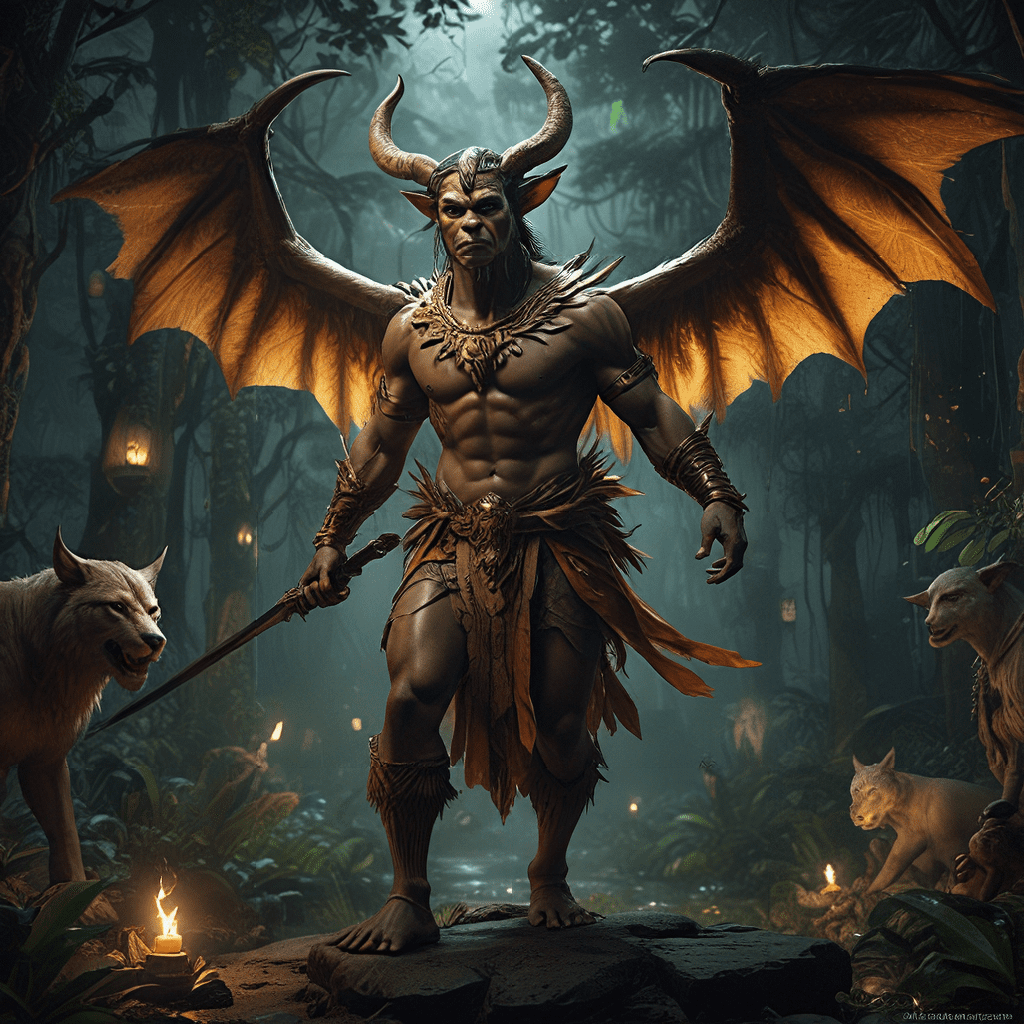The Indonesian Archipelago: A Realm of Myth and Legend
Indonesia, a vast archipelago of over 17,000 islands, is steeped in a rich tapestry of myths and legends. From the towering peaks of the Himalayas to the depths of the ocean, these stories weave a vibrant narrative of gods, spirits, and mythical creatures. Each island, each region, holds its own unique tales, reflecting the diverse cultural heritage of the Indonesian people. These myths, passed down through generations, offer a glimpse into the beliefs, values, and anxieties of those who came before us. They are a testament to the enduring power of storytelling, reminding us of our connection to the natural world and the spiritual realm.
The Significance of Gates in Indonesian Myth
In Indonesian mythology, gates play a pivotal role as symbolic portals between realms. They are not just physical structures but represent thresholds, transitions, and the boundaries between the known and the unknown. Gates act as pathways to otherworldly realms, connecting the human domain to the supernatural, the divine, and the ancestral. They signify the passage from one state of being to another, often marking significant events in a person's life or journey. Whether it be a gateway to the underworld, the mountaintop, the sea, or the forest, these portals are imbued with a sense of mystery and power.
The Gate to the Underworld: The Realm of the Dead
In many cultures, the underworld is a place of mystery and fear. In Indonesian mythology, it is often referred to as "Ngalimun" or "Neraka," a realm where the spirits of the dead reside. The journey to the underworld is often fraught with danger, requiring the aid of a guide or a ritual to navigate its treacherous paths. The entrance to this realm is typically guarded by mythical beings, such as the "Jaka Tarub" or the "Dewi Ratih," who control access to the underworld. In some myths, the gate to Ngalimun is described as a dark and foreboding cavern, hidden deep underground, while in others, it is a shimmering portal in the sky, leading to a realm of shadows and silence.
The Gate to the Mountaintop: The Abode of the Gods
Mount Merapi, Mount Bromo, and Mount Agung—these towering peaks hold a special significance in Indonesian mythology. They are believed to be the homes of the gods, the source of divine power and guidance. In many myths, the mountaintops are accessed through sacred gates, guarded by divine beings who oversee the spiritual realm. These gates are often described as shimmering portals, adorned with intricate carvings and precious gems. Reaching the mountaintop is a difficult journey, symbolizing the challenges of spiritual growth, but the rewards are immense, offering a glimpse into the secrets of the universe and a closer connection to the divine.
The Gate to the Sea: A World of Spirits and Mythical Creatures
The vast expanse of the Indonesian seas is a realm of mystery and wonder, filled with mythical creatures and spirits. From the gentle waters of the coral reefs to the depths of the ocean, the sea is a place where the boundaries between the real and the supernatural blur. In many myths, the entrance to the underwater realm is guarded by legendary creatures, such as the "Naga" or the "Buaya Putih", who protect the secrets of the ocean. The gate itself is often described as a swirling vortex, a portal that leads to a realm of shimmering coral palaces, coral reefs, and hidden treasures. The sea holds a powerful allure, representing the unknown, the untamed, and the mysteries that lie beyond our understanding.
The Gate to the Forest: A Realm of Ancient Powers
Indonesian forests, with their dense canopies and tangled undergrowth, hold a special place in mythology. They are seen as realms of ancient spirits, mythical beings, and powerful energies. These forests are often considered sacred spaces, where the line between the human world and the supernatural world blurs. In many myths, the forest is described as a gateway to the spirit world, where spirits of ancestors dwell, or where powerful mythical creatures roam. These spirits are often seen as protectors of the forest, and their presence is felt through rustling leaves, whispering winds, and the calls of unseen creatures.
The entrance to the forest realm is often marked by a sacred tree, a towering figure that stands as a guardian of the hidden world. This tree may be a banyan tree, a fig tree, or any other tree that holds a special significance in local folklore. These trees are often adorned with offerings, such as flowers, incense, or food, to appease the spirits that reside within the forest's embrace. The forest is a place of mystery, where ancient wisdom is whispered on the wind, and where the mysteries of nature are revealed to those who listen closely.
The Gate to the Sky: The Path of the Ancestors
In Indonesian mythology, the sky is often seen as a celestial realm, the home of the ancestors and the gods. This realm is often accessed through a sacred gate, a celestial portal that connects the human world to the divine. The gate to the sky is often depicted as a shimmering gateway made of clouds or stars, a bridge over which the souls of the departed travel to the afterlife. The celestial journey is often depicted as a challenging climb, symbolic of the trials and tribulations of life. Those who make the journey are often aided by mythical beings, such as the garuda, a bird-like creature with wings of gold, who carries them to their final destination.
The gate to the sky is not only a gateway to the afterlife but also a reminder of our connection to the cosmos. It represents the belief that the souls of our ancestors live on in the celestial realm, watching over us and offering guidance from beyond. This belief reinforces the importance of honoring ancestors and acknowledging their continued presence in our lives.
The Gate of Dreams: A Bridge Between Worlds
In Indonesian myths and legends, dreams are often seen as a bridge between the world of waking consciousness and the realm of the subconscious. They are a place where the boundaries between reality and imagination blur, and where spirits, ancestors, and mythical beings can interact with the human world. The gate of dreams is often depicted as a shimmering portal, a doorway that opens to an ethereal realm, filled with fantastical imagery and symbolism.
Dreams are often seen as a form of communication with the spiritual world, offering glimpses into the future or providing guidance from the ancestors. Dreams can be powerful and mysterious, reflecting our deepest desires, fears, and anxieties. In many myths, dreams are seen as a form of prophecy or a way to communicate with the gods. The realm of dreams is a place of mystery and wonder, where the rules of reality are suspended, and the limits of the imagination are pushed to their boundaries.
Theories on the Origins of Gate Motifs
The prevalence of gate motifs in Indonesian mythology can be attributed to a number of factors. One theory suggests that these motifs are rooted in ancient animistic beliefs, where spirits are believed to inhabit every aspect of the natural world. Gates were seen as physical representations of these spiritual realms, providing a way to interact with the unseen world. Another theory suggests that these motifs are linked to the practice of ancestor worship, where the deceased are believed to continue to exist in a spiritual realm. Gates represent the transition between the world of the living and the world of the dead, a passageway for the souls of the ancestors to return to the mortal realm.
These motifs are not just found in myths and legends, but also in traditional architecture and art. The entrances to temples, palaces, and houses often feature elaborate gates, decorated with intricate carvings and symbolic representations of the spiritual world. These gates function as more than just gateways; they serve as a reminder of the spiritual realm and its connection to the human world.
The Role of Gates in Ritual and Ceremony
Gates play a significant role in traditional rituals and ceremonies in Indonesia. They are used to mark transitions, such as birth, marriage, and death, or to invoke the presence of spirits and gods. During religious ceremonies, priests and shamans often use gates as a way to connect with the spiritual realm. They may offer prayers and offerings through the gate, seeking blessings or guidance from the unseen world. In some rituals, gates are used to create sacred spaces, separating the realm of the human from the realm of the divine.
The symbolic meaning of gates in Indonesian mythology and ritual is complex and multifaceted. They represent thresholds, transitions, and the boundaries between realms, reminding us of our connection to the natural world and the spiritual realm. These gates are more than just physical structures; they are pathways to the unknown, the unseen, and the divine. They offer glimpses into the mysteries of the universe and the enduring power of storytelling, reminding us of the rich cultural heritage of the Indonesian people.
FAQ
Q: Are there any specific examples of gate motifs in Indonesian mythology?
A: Yes, there are many examples. For instance, the "Gerbang Dwarapala" is a common motif in Javanese temples, representing the guardians who protect the sacred space. The "Gerbang Tondo" is a traditional gate found in many villages, often decorated with carvings of mythical creatures.
Q: What is the significance of gates in ancestral worship?
**A: ** Gates play a crucial role in rituals related to ancestral worship. They represent the transition between the world of the living and the world of the ancestors. Offerings are often made through these gates to appease the spirits of the ancestors and seek their guidance.
Q: How are gates used in modern Indonesian culture?
A: Gate motifs are still common in modern Indonesian art and architecture. They symbolize tradition, heritage, and the connection to the spiritual realm. They are also used as decorative elements in contemporary design, adding a touch of cultural significance to modern spaces.



